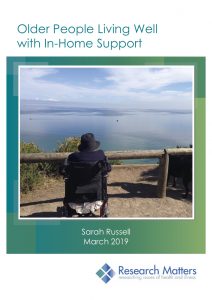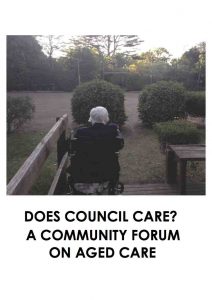Category: Home Care
Let’s restore humanity to aged care
After the heart-breaking revelations of the Aged Care Royal Commission, I hoped stories of neglect and poor treatment of older people were behind us. Not so, thanks to the decision of some local councils to wash their hands of aged care services.
Just this week we have heard that thousands of vulnerable of older people have been left without home care after Mornington Peninsula Shire Council and Boroondara Council outsourced their services to corporate providers.
Profits over People: in-home care a cash bonanza for greedy aged providers
he only aspect of in-home care for older people that makes the news is the ridiculously long queue for home care packages. Flying under the radar is the chronic rorting, with corporate providers skimming off vast profits.
The Aged Care Royal Commissioners noted that a recipient of a Level 4 home care package worth $53,000 received on average just 8 hours and 45 minutes of support. Surely this was a big red flag.
Consumer views of self-managing a home care package
KPMG – A SIRs for home and community care settings
KPMG’s ‘A SIRs for home and community care settings co-design paper’ highlights that co-design is merely a buzz word in aged care.
I attended KPMG’s co-design focus groups on Serious Incident Response Scheme for home and community care. I have no words to describe just how bad it was. I don’t blame the facilitator – she appeared to be very inexperienced. I do however blame the federal department of health for commissioning this type of work from organisations with no expertise in genuine co-design of health and social services.
I wrote to the organiser to express my views of the focus group.
Hi [Name of facilitator]
I apologise if I was unduly critical of yesterday’s group discussion/consultation.
I am committed to genuine co-design of health and social services, including aged care services. Not surprisingly, it frustrates me when organisations appropriate language without any regard for the practice that underpins a community engagement methodology.
When I read KPMG’s “A SIRs for home and community care settings co-design paper”, I was concerned by the document’s lack of substance. Do the authors have any expertise in home care? I attach my feedback to this document.
I have also included Mary Ivec’s feedback below. Mary self-manages her mother’s Level 4 HCP.
I read some of Mary’s feedback during the meeting. The participant who said “That did not answer the question” was correct. It didn’t. But I felt it needed to be said.
Like Mary, I support relationship based regulation for older people who receive services in the home. I also agree with Mary’s comment about “natural circles of support” (i.e. family members, neighbours, church group members, friends, GP, pharmacy, podiatrist, medical specialist, dentist, and if no-one is around – community visitors)
Based on my research with over 100 older people and families who use home care, it is a mistake to model SIRS for home and community care on residential care – given the different capacity of residents in aged care homes and older people who receive support to live at home.
In my view, it is worth considering successful approaches to elder abuse in home and community. For example, have you reviewed New Zealand’s restorative approaches to elder abuse? Or Senior Rights’ successful model to support those who have experienced abuse in home and community?
To assist with yesterday’s meeting, I collected some wonderful ideas from recipients of HCPs and CHSP. However, the questions you asked provided no opportunity to share these ideas.
I had intended to thematically analyse this ‘consumer feedback’ but, after yesterday’s meeting, I see no point.
Consumer experiences of home care packages
Australasian Journal on Ageing Article
Research Report: Older people living well with in-home support
Home Care: operators snipping 50pc fees from the elderly in home care
The media has been reporting story after story of appalling treatment in aged care homes. But aged care is much more than residential care. It also includes home care packages and the Commonwealth Home Support Programme.
Opinion Piece in Michael West
Presentation on the recent home care research
Talk given to Leadership team of Care Connect on March 25 2019

